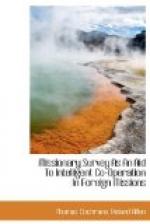This physical survey would naturally result in the production of a map of the area in which the cities, towns, and villages in the station district were marked with notes on their character from the missionary point of view. In this map all places where Christians resided, where there were Christian congregations, churches, preaching places, schools, hospitals, dispensaries, etc., would be marked. It would be a pictorial presentation of the facts so far as they were capable of expression in map form.
But whether in map form or in statistical form, the area and the population for which the mission is working must be expressed either by exact figures or by estimates if we are to trace progress.
If these tables were kept over a number of years, the missionaries on the spot and directors and inquirers at home would be able to see what progress was being made towards fulfilling the obligation implied by the definition of the station area or district, and what that obligation involved.
II. When we know the work to be done we turn to the consideration of the force available. This force consists of permanent and more or less temporary members. Some will in all human probability remain in the place till they die; they are of it, they belong to it; others will probably depart elsewhere; they are not of the place; they speak of home as far away; they are liable to removal; sickness which does not kill them takes them away; the call of friends or business carries them back to their own land; they are strangers all their days in the mission district. Nevertheless, they are generally the moving, active force; upon them progress seems to depend. It is strange, but it is true generally: the permanent is the passive element, the impermanent is the active. Here we simply state the fact to excuse or condemn the placing of the missionary force first in our tables. First it is to-day.
We need then a table of the foreign missionary force. In its form it will be a mere statement of proportions. The proportions are essential in order to make comparison between one area and another possible; and comparison is the sweet savour of survey. We cannot compare the work of three men labouring among an unstated population with the work of two other men working in an unstated population; the moment that the proportions are worked out the cases can be compared. But some men detest this purely quantitative comparison. They insist, and rightly, that there is no true equality in the comparison. One man differs from another man and his work differs from the work of the other man: over large areas it is often the work of one man among many which really saves the situation. It is quite true. In the last resort survey becomes survey of personalities. But in a survey of the kind which we propose, survey of personalities is impossible and most undesirable.




